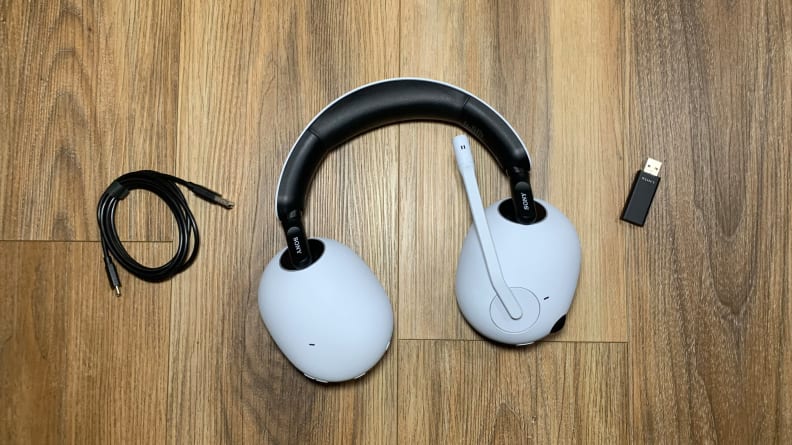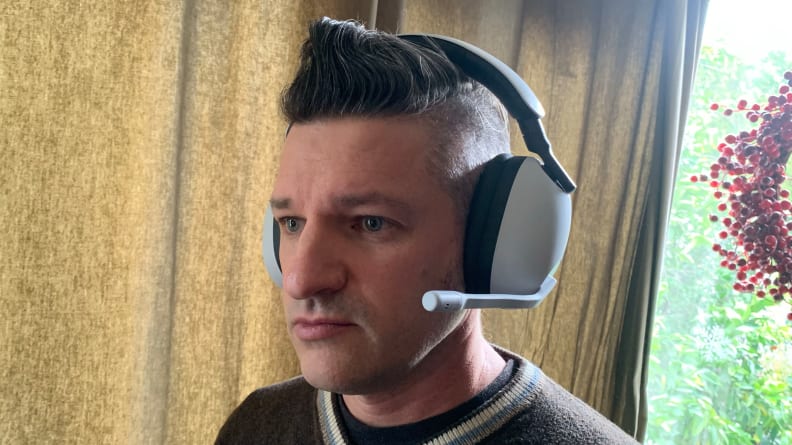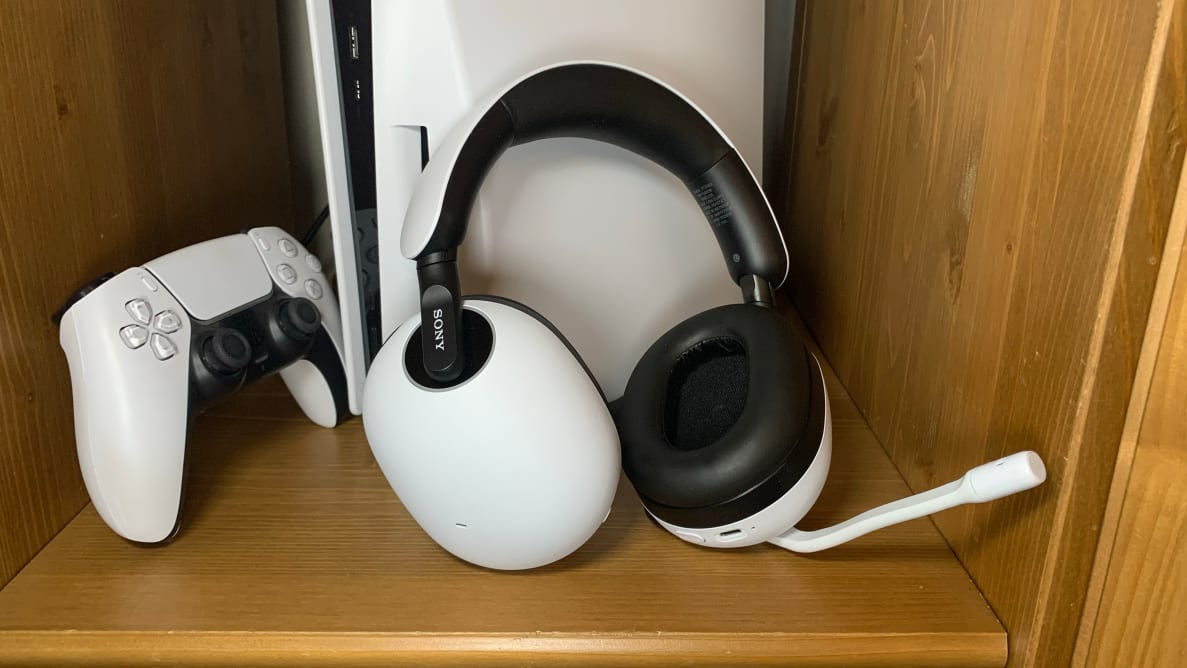Pros
-
Impactful sound
-
Feature-rich
-
Long battery life
Cons
-
Interface is tricky
-
Consistency issues
-
Not travel-friendly
About the Sony Inzone H9

It comes with a USB cable and a USB-A dongle, despite not having a wired connectivity option.
Here are the specs of the headset we tested:
- Cost: $300
- Style: Over-ear, closed-back
- Colors: White with black accents
- Drivers: 40mm drivers
- Connections: 2.4 GHz via USB-A dongle, Bluetooth 5.0
- Battery life: 32 hours
- Device compatibility: PC, PlayStation 5 (2.4 GHz wireless); other (Bluetooth)
- Microphone: Bidirectional boom microphone, flip-to-mute
- Virtual surround sound: 360-degree Spatial Audio (Windows Only), Tempest 3D (PS5 only)
- Noise canceling: Yes
- Weight: 326 grams (11.5 ounces)
The Inzone H9 is Sony’s flagship gaming headset, and sits at the top of the stack of three headsets. The Inzone H7 is largely identical to the H9, but lacks active noise cancellation. Meanwhile, the Inzone H3 is a more basic wired headset that can be found for under $100.
Like the Sony Inzone M9 and forthcoming M3 monitors, the Inzone headsets are intended primarily for PC gaming but are also compatible with the PS5.
What we like

The pads are quite comfortable and squishy.
Convenient connectivity
The Sony Inzone H9 provides a few ways to get connected to your audio sources and a triage system between them.
With the USB-A dongle, the Inzone H9 creates two different data streams, one for game audio and one for chat audio. This allows for on-the-fly sound balancing between the two without pulling up the relevant apps or menus. So one loud teammate won’t throw you out of the game for 30 seconds while you try to hush them, and a teammate’s callouts won’t be drowned out if you find yourself in a loud game environment.
The convenience of the 2.4GHz wireless connection is great, but Sony also tacked on a Bluetooth 5.0 connection. So, you can throw a phone or other device into the mix. The headset will juggle its two 2.4GHz wireless connections alongside the Bluetooth connection, so you can play music or podcasts from your phone while you play with friends without a hitch. You just need to manage Bluetooth volume through the source device.
More connectivity options mean more ways to use the headset, and that’s a plus when you’re spending nearly $300 on a set of cans. It’s regrettable there’s no option to run the headphones over a wired USB or 3.5mm connection, but it’s got most bases covered with wireless.
The booming audio
The Sony Inzone H9 can pump it out. This headset easily pushes respectably crisp audio at high volumes that make for an especially impactful gaming experience. You don’t have to worry about finding a quiet environment to game in, because these can easily drown out external sound.
The chaotic environment of Call of Duty: Modern Warfare II’s new Warzone and DMZ modes is driven home with the Inzone H9’s booming speakers. I felt urgency to find cover when an enemy rocket detonated right next to me. The audio cue of my armor cracking was clear as day and helped me respond accordingly.
When it’s quiet, the headphones still make subtle sounds audible. After clearing a village in the game, my team posted up on some rooftops, and while we waited for the circle to shift, I listened carefully to pick up any faint sounds of distant players sneaking through our village below.
The audio helped me keep track of enemies in my surroundings, letting me train my crosshairs on entrances and cover to wait for players to pop up.
The mic clarity
While I’d love every headset mic to sound as rich and clear as a dedicated condenser mic, that’s not realistic. The Sony Inzone H9 doesn’t go quite that far, but it does a solid job without requiring extra software. The mic arm is easy to position, and once it’s close to the side of your mouth, your teammates will definitely hear you.
Even with a fan and air purifier running in my small room, the Inzone H9 mic stayed focused on my voice. It almost completely eliminated the background noise. Better still, it hardly picked up my keyboard and mouse. The mic lacks the crispness and fullness you’d want for a live streaming setup, but it will absolutely do for communicating with other players.
What we don’t like

There are too many buttons that are a bit hard to press and create too many meaningless beeps.
Signal issues
Throughout my testing, I noticed one issue too frequently: signal degradation. While the Inzone H9 largely stayed connected to its wireless USB transmitter, even if I went a few rooms away with plenty of walls between the headset and the dongle, the connection didn’t always remain pristine.
Sometimes I’d notice the audio quality dip with stuttering and strange digital artifacts from only seven feet away. It almost never ran into this issue while I stood at my computer with only four feet and line of sight between the dongle and headphones. But my experience with similar wireless headphones from SteelSeries (such as the Arctis Pro Wireless, Arctis 9 Wireless, and Arctis Nova 7 Wireless) never saw this sort of behavior in such a short range.
The interface
The Sony Inzone H9 is simply not that intuitive to control, especially when it’s on the head. The volume dial on the left earcup is fine and easy enough to feel out, though it takes a few spins to fully increase or lower the volume, and the tactility of it spinning doesn’t feel great. On the opposite earcup, there are controls for chat and game volume balance, but they’re buttons that take more pressure to press than expected.
I’ve loved the Chatmix dial on many SteelSeries gaming headsets for how quickly it makes this balance adjustment. By contrast, I feel like I always have to fuss around with the Inzone H9 to figure out first which button I need to press to make the adjustment I want, and then have to spend more time tapping it to get my desired level.
It doesn’t help that the headset communicates with meaningless beeps. Many of them aren’t that useful, such as beeping twice when a volume setting is maxed out. But even worse, I never even noticed a low battery indication from the headset until I was in the middle of a Warzone firefight and the headset simply shut off.
On-the-go features; Leave-at-home design
The Sony Inzone H9 has features like a headset you might want to take everywhere, and it's comfortable enough for all-day use thanks to plush padding in the headband and ear cups, but you’ll probably want to leave them at home. Its Bluetooth connection means you can pair it easily enough with laptops or phones for away-from-home listening. It also includes modest ANC (Active Noise Cancellation) and an ambient sound mode.
Despite these features, the headset itself is not the sort you’d want to take everywhere. Sony doesn’t include a case, for one thing. The headset’s boom mic might flip to mute, but it doesn’t retract or detach, so it’s always going to be sticking out at the side. Then there’s the fact that these headphones are huge (and look kind of like giant eggs). I measured the earcups at 2.44 inches deep, 4.37 inches tall, and 3.5 inches wide. That’s larger than my monstrous Monolith M570s, which at least justify their size by housing 100mm drivers.
Should you buy the Sony Inzone H9?

It may be too faulty to justify its price tag.
Maybe, if you really want ANC
The Sony Inzone H9 is a powerful pair of premium gaming headphones, but it don’t quite live up to the price tag and falls prey to the same mistakes that made the Razer Barracuda Pro a flop. The headset may sound good, but it isn’t noticeably better than headphones costing one- to two-thirds less.
If sound quality isn’t the H9’s advantage, then it has to try to compensate with ANC and connectivity features. While the ANC may stand out, I didn’t find it useful in the easier-to-control home environment, and the headset is simply too bulky to enjoy on the go. The option to connect either over a lag-free wireless connection or Bluetooth is handy to have, but a handful of headsets already offer it. Even the now-dated SteelSeries Arctis 9 Wireless offered a better system for wireless connections alongside wired connectivity, at a lower price two years ago than the Inzone H9 comes in at today.
Most people considering the Sony Inzone H9 will likely be served just as well by the cheaper Inzone H7, which ditches the ANC but is otherwise nearly identical and can be found for $148. Everyone else should just turn to the Arctis Nova Pro Wireless.
Meet the tester

Mark Knapp
Contributor
Mark Knapp has covered tech for most of the past decade, keeping readers up to speed on the latest developments and going hands-on with everything from phones and computers to e-bikes and drones to separate the marketing from the reality. Catch him on Twitter at @Techn0Mark or on Reviewed, IGN, TechRadar, T3, PCMag, and Business Insider.
Checking our work.
Our team is here to help you buy the best stuff and love what you own. Our writers, editors, and experts obsess over the products we cover to make sure you're confident and satisfied. Have a different opinion about something we recommend? Email us and we'll compare notes.
Shoot us an email


